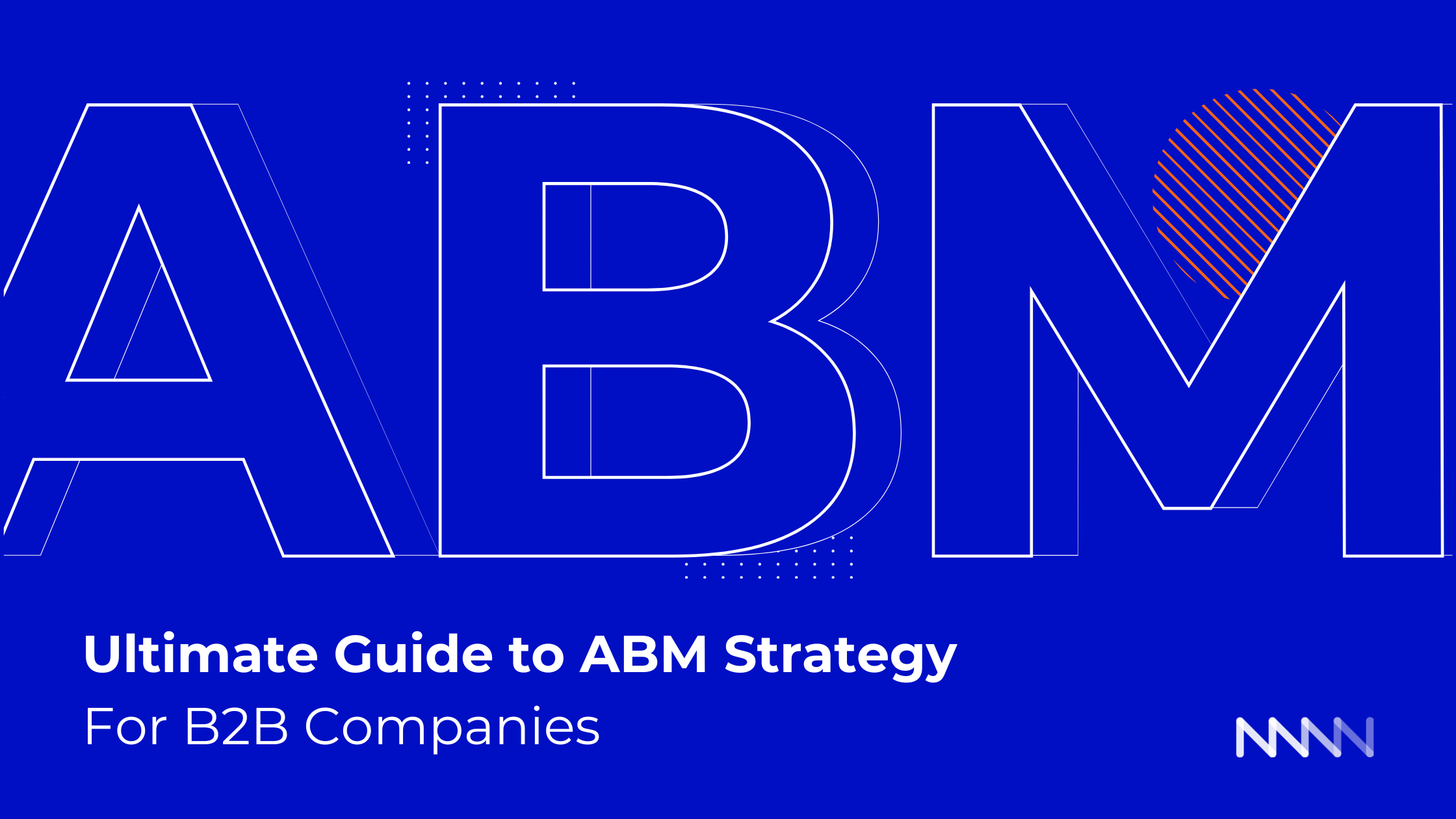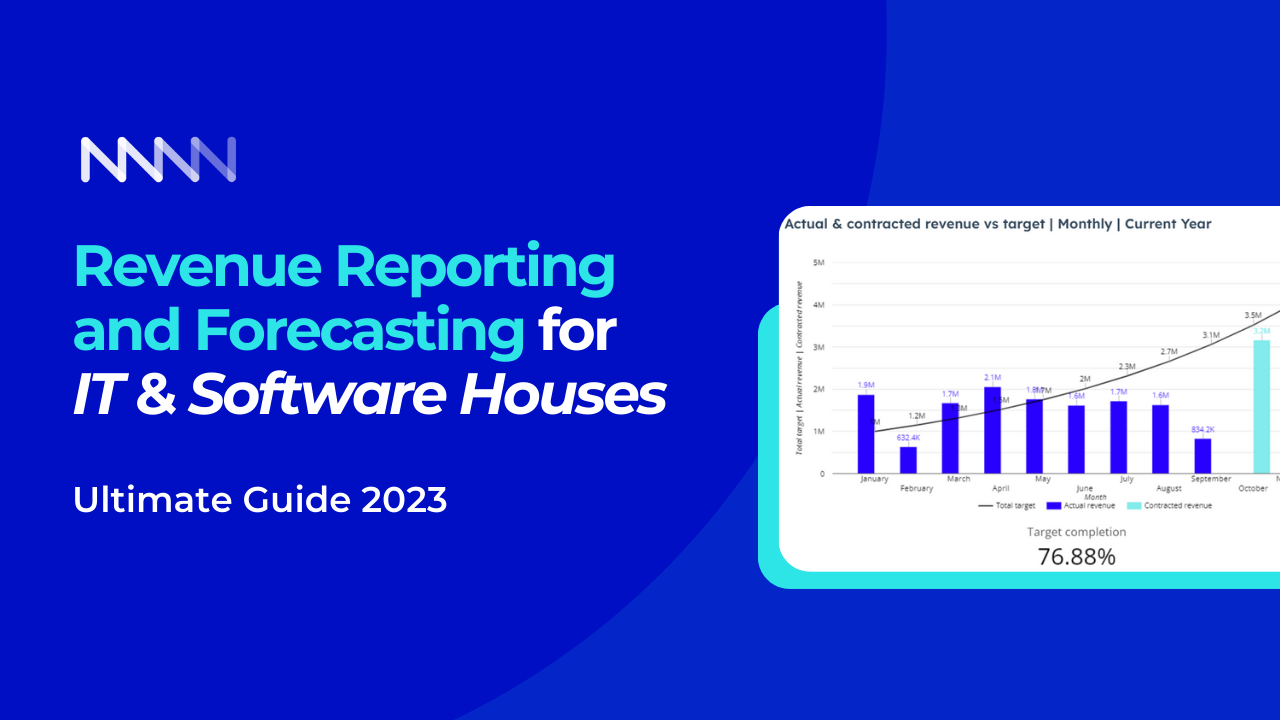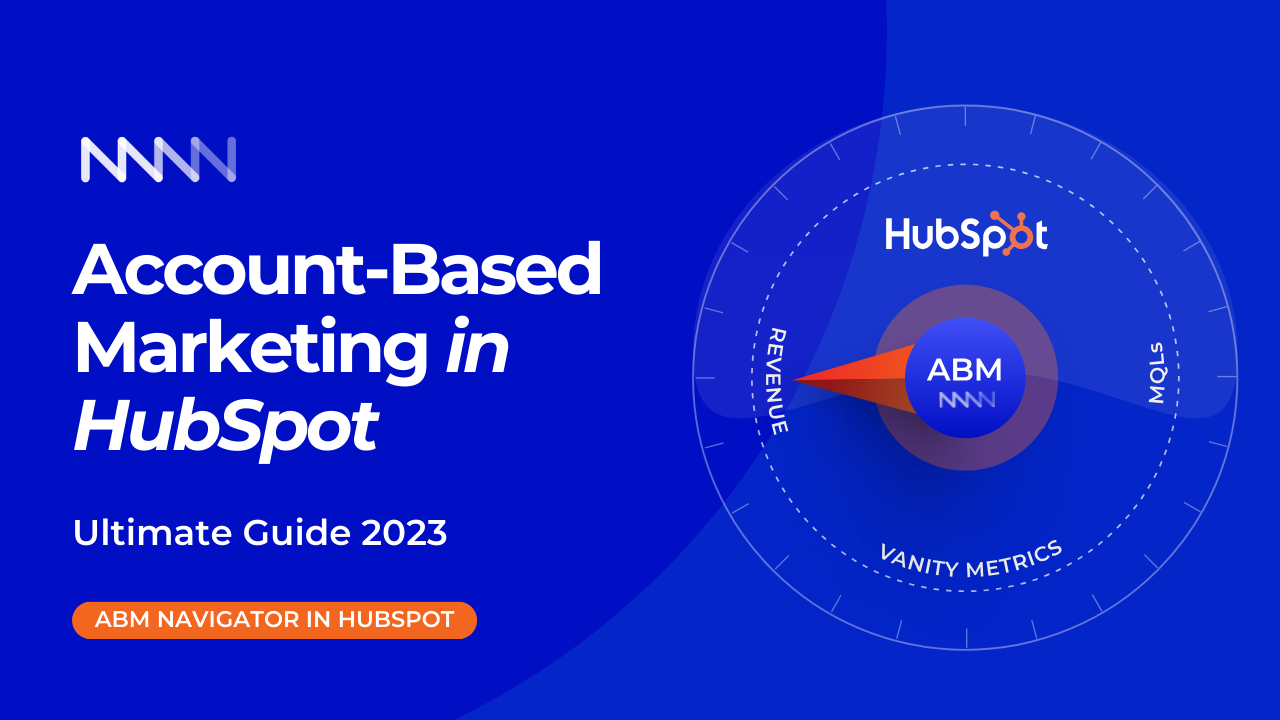How to Identify Target Accounts & Attract Right Leads [ABM for Tech]
In this blog post, we break down the process of finding, segmenting, and listing your most valuable clients.
Account-Based Marketing (ABM) is a growth strategy built around target accounts - real-life companies that sales and marketing identify and pursue together.
ABM beats lead generation both in terms of acquisition costs (-40%) and win rate (+285%).
When we adopted ABM at MAN Digital, we started following the TEAM framework.
- Target
- Engage
- Activate
- Measure
Identification and segmentation of target accounts fall under the Target stage and determine the success of your ABM campaigns.
Let's see how we at MAN Digital identify and segment target accounts, and how you can do the same for your business.
To see the bigger picture, download our free ebook on Account-Based Marketing for Tech Businesses.

Table of Contents
Identify Your Target Accounts: External Approach
Account-Based Marketing is about building long-term relationships with companies that are the best fit for your offer.
How? By developing personalized content and running highly targeted campaigns that reflect the wants and needs of your real-life ideal clients.
Naturally, you want to make sure you choose right before investing your time and effort.
No worries: unlike with human relationships, there's science to choosing the right target accounts.
We'll now explore the different approaches, starting with the external one.
Market Segmentation
The external approach, as the name suggests, boils down to looking on the outside of your business operation to find ideal clients you could target.
For this, you'll need to examine and segment the market you're serving.
- Total Available Market (TAM)
- Serviceable Available Market (SAM)
- Serviceable Obtainable Market (SOM)
- Target Accounts
Here's an example of how you can visualize the breakdown as a software house.
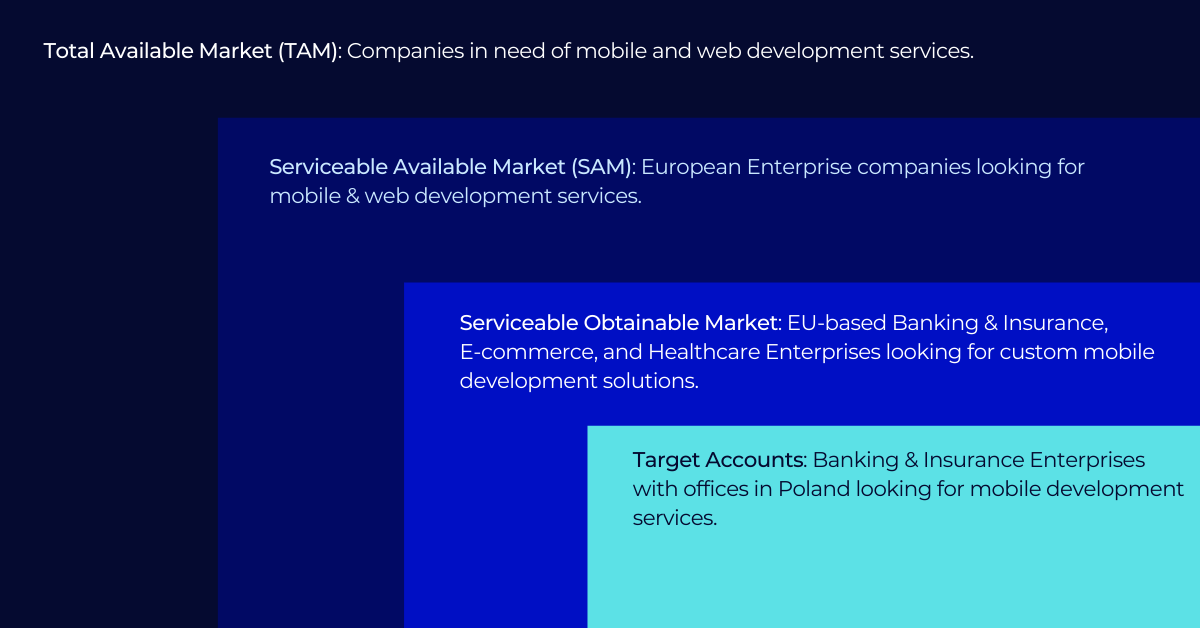
Your Total Available Market represents the total market demand for your products or services.
For a software house delivering web and mobile development services, this would be companies of any size and industry that might require mobile and web development services.
Since we're attempting to cover literally every industry and company size, there's no realistic way to measure it. But that's okay.
We're talking about a huge total demand here, and you won't be serving the entirety of any given market. Let's look closer.
Your Serviceable Available Market is a segment of TAM within your geographical reach.
As a software house, you'd define these as companies in your geographical reach that could need your products and services.
While this is still a huge pool of companies to dip in, you could run a Google search for company directories or simply use LinkedIn filters to uncover specific names.
Still, even with the geographical limits, we're talking about the clients that could benefit from your products and services.
Let's now think about the clients you could realistically manage with your resources.
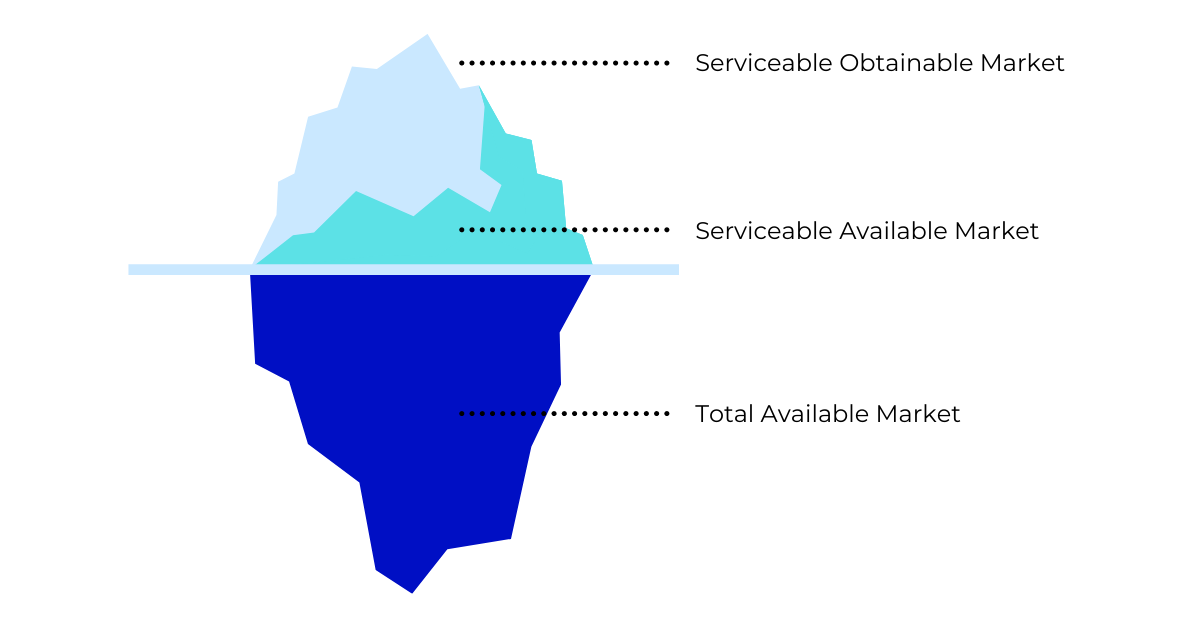
Serviceable Obtainable Market is a segment of SAM you can capture. This is where we get specific with industries, further define the location, and name the precise services you could render.
For our hypothetical software house, these would be EU-based Enterprises representing Banking & Insurance, E-commerce, and Healthcase industries.
With a specific description like this, there's a reason to dive deeper into LinkedIn search or even explore data companies like Discover.org.
Finally, we come to Target Accounts - the actual companies you will be pursuing.
This is the end result of market segmentation. We've come to the smallest segment of your total market - businesses that are as much a good fit for you as you are for them.
Now that we've covered market segmentation, let's move on to customer segmentation.
Customer Segmentation
When we talk about customer segmentation, we refer to a similar breakdown to the one we did for the market.
Only this time, we'll be grouping clients by shared attributes and characteristics that matter to us.
In B2B, customer segmentation may rely on factors such as industry, location, number of employees, etc.
Since we covered these as part of market segmentation, let's now look at some other factors that would help us identify the best target accounts.
As a software house, we'll go with urgency and tech stack.
Here's what it could look like.
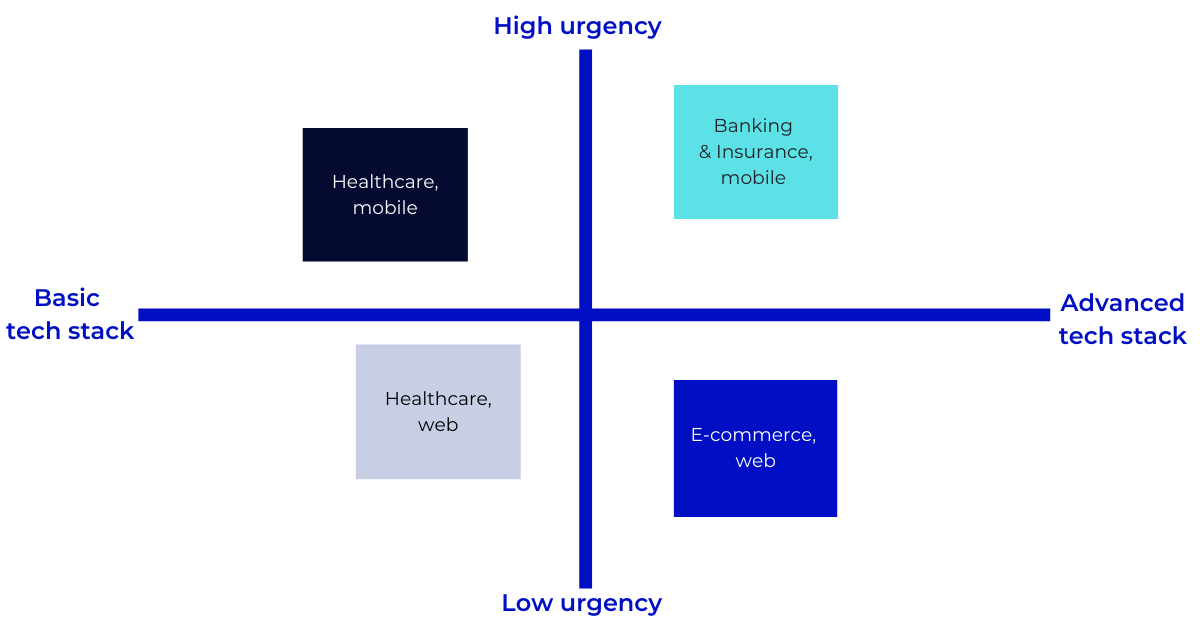
As you can see, we segmented potential software house clients according to how urgently they need services and how advanced their tech stacks are.
The beauty of customer segmentation is that you set your own rules and choose the categorization criteria valid for each campaign.
Once you have the layout and understand the placement of your ideal clients, you've one step closer to building relationships with them.
ABM Segmentation
We'll now look at the mechanics of ABM segmentation. For this, we'll be treating our target accounts as part of target markets.
Below is the visual representation of the target market concept.
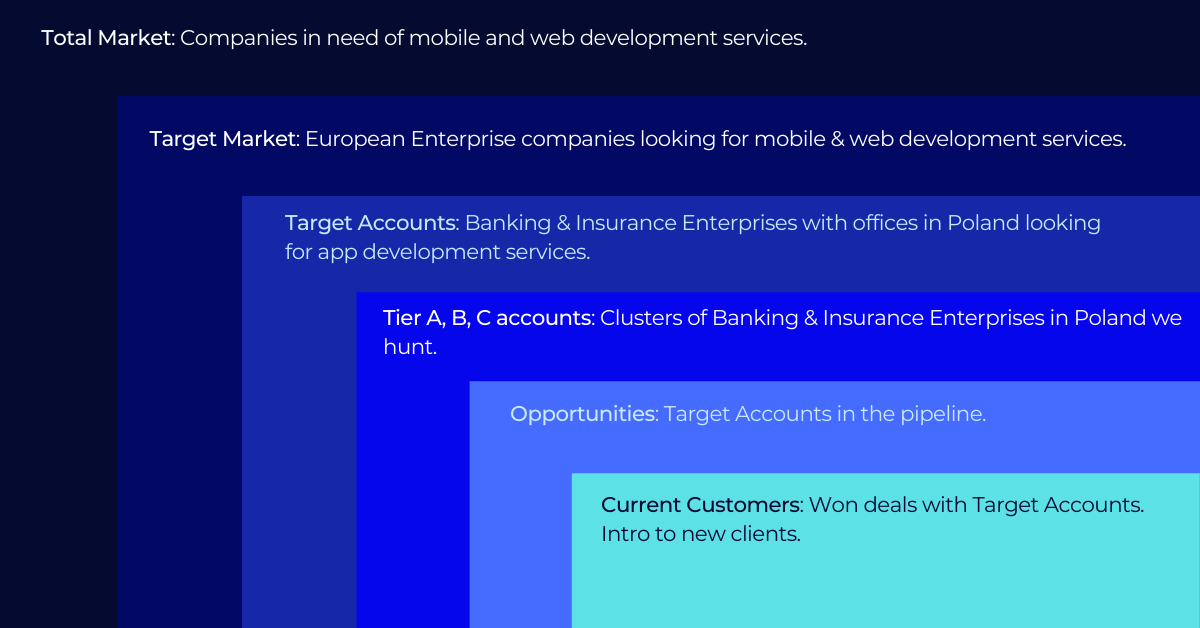
First we have the Total Market. It corresponds to the Total Available Market from market segmentation and reflects the entirety of demand for your services.
Then comes the Target Market. In ABM segmentation, this would be the equivalent of Serviceable Available Market, i.e. demand within your geographical reach.
Target Accounts are your ideal clients. They're a good fit for you and you're a good fit for them. These are the actual companies you target with your ABM campaigns.
Then go Tier A, B, C accounts. They are clusters of Target Accounts that you pursue at one time. Tiers are assigned depending on account priority, with Tier A being top-priority accounts (more on that later).
Opportunities are Target Accounts in the pipeline. They've had the most interactions with your content and team, and display the highest potential.
Finally, we have Current Customers. These are the deals you've won and are working to expand.
Account-Based Marketing operates by the 'land and expand' principle. This means that you aim to build up on the deals you won and expand your relationships to new projects and referrals.
Identify Your Target Accounts: Internal Approach
Now that we've looked on the outside, it's time to turn inward and start searching for your target accounts from within your business operation. Here's how.
- Who are your target accounts?
- Companies that match the criteria of your ideal clients.
- How do you know for a fact which clients are ideal for you?
- By looking at the most successful clients you currently have.
Makes sense, doesn't it. What better way to be sure that a target account is the right choice than to benchmark them against your actual best clients?
Which brings us to the steps to take within the internal approach.
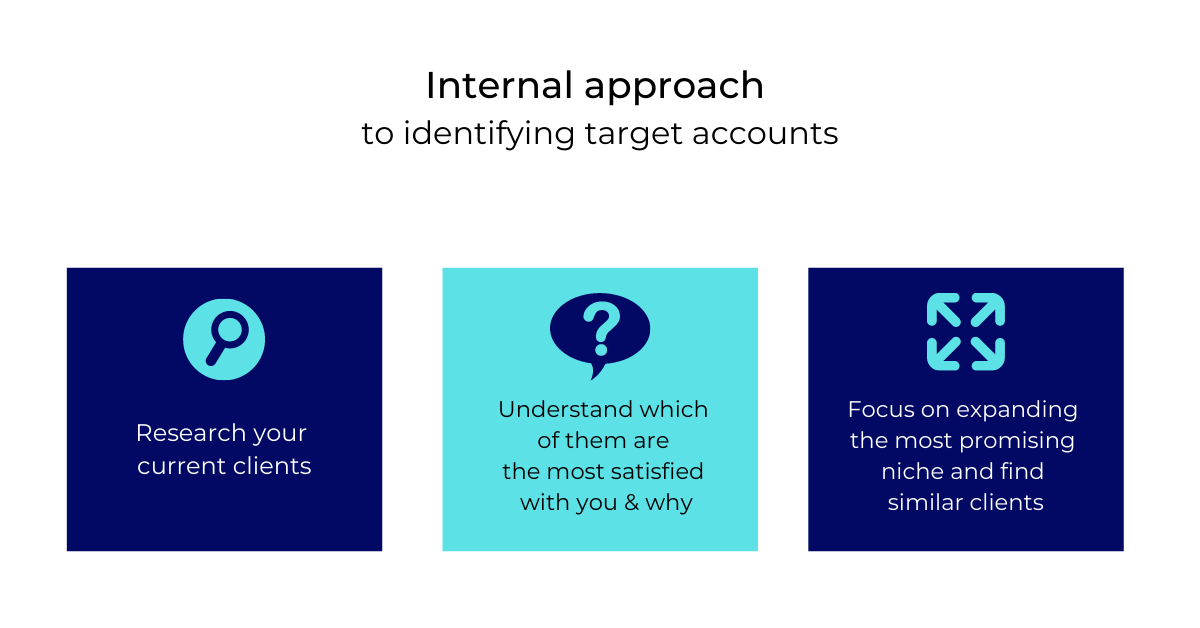
Research your current clients
Researching your clients is really as hard or simple as your CRM and marketing automation platform allows.
At MAN Digital, we use HubSpot and can leverage it when researching our current clients and organizing the work around target accounts.

Don't have a sophisticated CRM platform? Open an Excel sheet.
Ultimately, the research boils down to taking a close look at your largest deals.
Start with your 10 biggest clients and talk to the people who closed these deals on your side. Then, try to set up interviews with the actual decision makers from these respective companies.
What you're interested to find out during these calls comes below.
Understand which of them are the most satisfied with you and why
When you're talking to your biggest and most successful clients, you want to know what led them to buying from you.
- How well did your services address the customer's pain points?
- When and how did they find you?
- What was the exact moment in time when the customer made the decision to buy from you?
- What's your biggest competitive advantage from the customer's perspective?
This list of questions is of course not exhaustive and you can improve it and get more specific as you go.
The important thing is to treat these feedback sessions as the premise for more extensive cooperation in the future.
Focus on expanding the most promising niche and find similar clients
Now that you're armed with the knowledge of what makes your company a good fit for your biggest clients, you can go ahead and draw similarities between them.
As you gain more insight into your most successful clients, you'll find it easier to identify new companies that fall under the same criteria.
In addition to that, you're obviously interested to expand your cooperation and will bring it up with the decision makers you're interviewing.
Use the calls to identify your strengths and focus on bringing more value to your biggest clients and companies similar to them.
Sure - this kind of research takes time. Still, it's the most accessible and credible data you can get on your best buyers, so it makes sense to apply the internal approach to its full potential.
Segment Your Clients
When going after target accounts, it's crucial to segment them.
You need this for two reasons.
One - not all target accounts are created equal. Some are better suited for your offer and should therefore be prioritized.
Two - you'll be pursuing dozens and hundreds accounts at a time. To make it happen, you need to put them in clusters for the sake of messaging effectiveness.
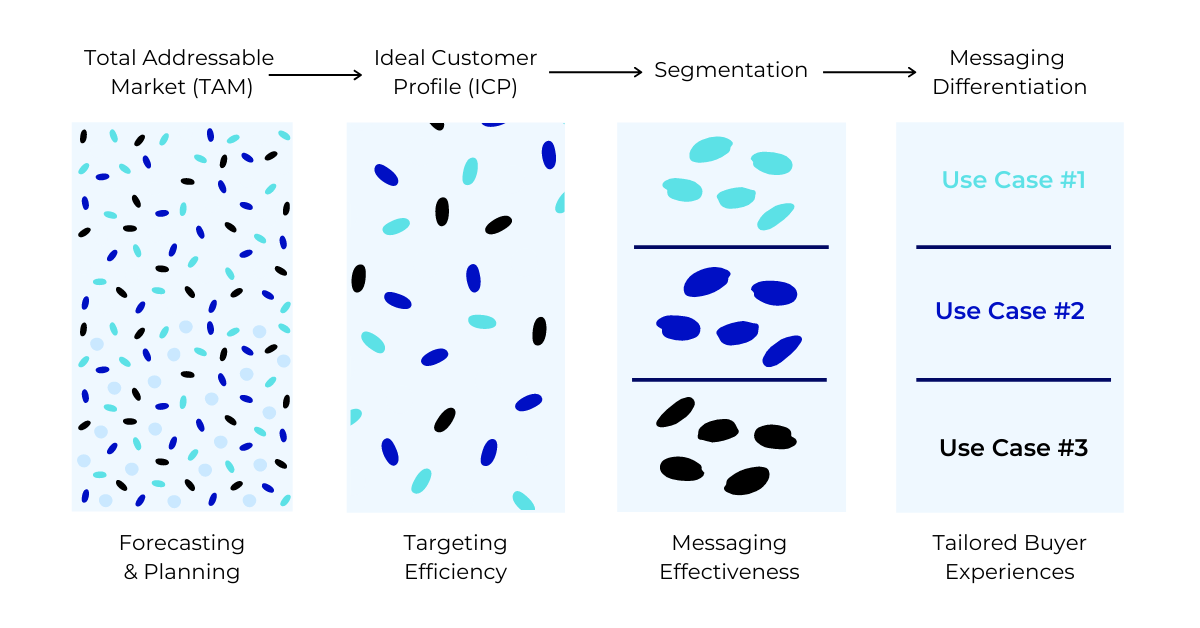
In order to benchmark and segment your target accounts, you need criteria. This section is all about defining and applying your criteria to prospective clients.
Ideal Customer Profile
Ideal Customer Profile is a description of the company that is your perfect client, i.e. essentially, your target account profile.
Say, a software house targeting Banking & Insurance Enterprises in Poland would define ICP like this:
Our perfect client is a Banking & Insurance Enterprise company with offices in Poland that employs 1000+ people and needs an app for account management.
ICP follows the same logic as buyer personas - only here we aim to describe a perfect company and not an individual end user.
If you adopt ABM, do you get rid of your buyer personas?
Not exactly. Your ICP represents a company that is still made of individuals who may or may not be on the list of your buyer personas.
Like all things within Account-Based Marketing, defining Ideal Customer Profile is a joint effort of your marketing, sales, and customer support teams.
The key is to get the full perspective and have contributions from the entire ABM team.
ICP Models
When it comes to the building blocks of your ICP, there are many to think about. Company size, budget, frequence, and advocacy potential are just a few of them.
All these factors help you determine which companies are likely to be a good fit for your offer, and by how much.
To help you get started, here's a template we use at MAN Digital.
For example, as a software house targeting Banking & Insurance Enterprises with officed in Poland, you would be able to define your best potential clients by how well they can see the problem and how actively they're looking for a solution.
With segmenting, you are also looking at things like project scope or how frequently your services will be needed.
These help you prioritize the deals and focus on the companies that display the most potential.
The more thorough you get with filling out the form, the more laser-sharp your focus gets.
ICP Tiering
There are 3 Tiers of target accounts referred to as A, B, C or 1,2,3.
Like any other target accounts segmentation, tiers are meant to reflect the level of prioritization you assign to prospective clients.
Only with tiers, you'll also be making assessments of how much strategic value your target accounts offer.
Tier A are high-priority accounts.
They are the closest to your Ideal Customer Profile. They match the criteria for your best-fit companies, including your current most successful clients.
Tier A accounts offer the highest lifetime value as they are well-known within their industries and will likely be anchors for similar accounts.
Tier B are medium-priority accounts.
Those are your workable fits. These accounts match some of your ICP criteria but fail to meet others. Therefore, their strategic value is lower than that of Tier A accounts.
These could be companies of non-ideal size or project scope than what you envisioned for your best clients.
Tier C are low-priority accounts. They match the fewest of your ICP criteria but have displayed intent by engaging with your content.
Tier C accounts offer the lowest strategic value and don't require a lot of personalization efforts.
Here's what this breakdown could look like for a software house.
- Tier A: Banking & Insurance Enterprises with offices in Poland
- Tier B: Banking & Insurance Enterprises with no presence in Poland
- Tier C: Banking & Insurance companies under 1000 employees with offices in Poland
Tiers is another way of assigning importance to target accounts.
You'll be investing most of your marketing effort into Tier A accounts. Because they are top-priority deals that require a high level of personalization, you won't have too many target accounts in this segment.
Meanwhile, you can have hundreds of accounts in Tier B and Tier C as you'll be automating most of the interactions and therefore can comfortably pursue many clients at a time.
Suggested Approach for ABM
Okay, you know your target accounts and segments.
How do you plan your ABM strategy in a way that lets you target these accounts with enough personalization and resources?
This is where ABM types step in.
ABM types are meant to structure the effort you put into targeting your ideal clients.
Depending on how you've segmented your target accounts, you'll want to make sure you have the resources to develop content and personalized campaigns for each.
Here's a visualization of the three approaches you can take to pursuing target accounts.

One-to-One ABM is the most targeted approach.
You focus on the absolute biggest deals and put all your effort into creating personalized experiences for them. Usually, we're talking 5-10 accounts.
One-to-Few ABM is about targeting clusters of accounts. Whatever factors you select for segmentation will determine the number of accounts within clusters.
Most often, you'll be dealing with 3-5 clusters of 5-25 target accounts. This requires some personalization but you can automate engagement based on the issues your clients have in common.
Finally, One-to-Many ABM is the approach you take with Tier C accounts.
With light personalization and marketing automation platforms like HubSpot, you'll be able to set up workflows for hundreds of accounts.
One way to execute this would be by adding dynamic content to your website and emails. Aka smart rules in HubSpot, this feature allows displaying different versions of your content based on certain viewer criteria.
This means you can create personalized journeys for your target account clusters, but make it fully automated. By doing so, you get to engage with hundreds of accounts at a time.
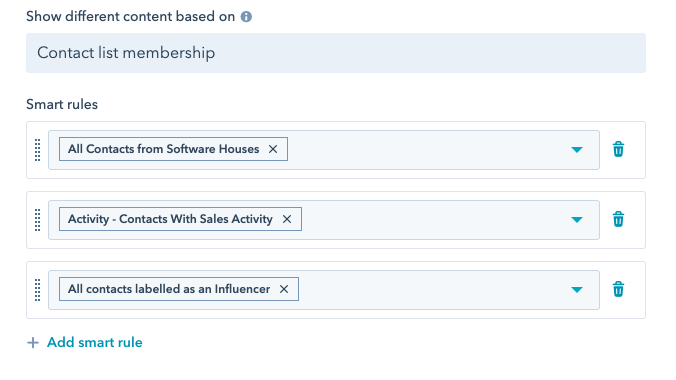
Then, you can focus on the leads within these accounts that engage with your content the most.
List Your Target Accounts
Finally, you know everything there is to know about identification and segmentation of your target accounts.
It's time to take action and make up a Target Account List (TAL).
But first...
Select list owner.
List ownership comes up a lot when researching target account lists. Because of sales and marketing alignment and shared responsibility, appointing a single list owner is often overlooked.
However, having a focal point for your target accounts list helps maintain accountability and make sure everybody on your ABM team knows their point of contact for the list's upkeep.
Target Accounts Listing
Everything you've learned about your prospective clients, as well as the way you've used these insights to segment them, is the groundwork for compiling an actual list of target accounts.
Now that you have your ICP, you can use many tools to build your target account list.
- Your CRM platform
If you're serious about Account-Based Marketing, you need to get serious about CRM platforms.
A CRM like HubSpot is not only a storage of contact information for your existing clients. It's also an AI-powered tool for finding new prospects.
Make sure you use your CRM's predictive tools and internal search to look for target accounts that match your Ideal Customer Profile.
If you don't use a CRM because you're only getting started and building your target account list from scratch, make sure you take advantage of LinkedIn.
LinkedIn is the media for B2B communication and relationship building. You can use LinkedIn search to research companies that match your target account criteria.
Speaking of free tools, you always have Google search.
This might seem obvious but you can use Google to research an industry and find target accounts within your geographical reach.
After you've run a scan of your target market, you can also dig up competition intel to see what kind of companies your direct competitors are working with.
- Glassdoor
Looking for target accounts you'll be building long-term B2B relationships with is not entirely unlike looking for a company to work at. Both require commitment and research, and both need some digging.
Make use of Glassdoor to get insights on your prospective clients the same way it's used for job research. Again, might be time-consuming but full of valuable findings if you're willing to look for them.
- Identification tools
Predictive tools like Discover.org can be a valuable source of target accounts insights. Again, you will be using your ICP for setting the search right.
Especially if you're only getting started with ABM, it's a good idea to check out several data companies and see what kind of target accounts they can deliver for you.
- Insider knowledge of your ABM team
Sometimes, the most valuable target account insights come not from predictive tools but from the people on your sales and marketing teams.
Regardless of the tech stack you'll be using for compiling your TAL, remember to bring your ABM team together for a brainstorming session.
Nothing beats experience and first-hand knowledge, so make sure you use this in-house asset before you settle on the list of accounts to target.
- Your current clients you'll be upselling to
Not to be repetitive, but ABM relies on long-term B2B relationships and the 'land and expand' philosophy.
When putting together a list of target accounts, always consider your current client base, especially the top-10 most successful clients you've interviewed as a preparatory step.
More likely than not, there's upsell and cross-sell potential you can explore as part of your ABM strategy.
With your knowledge of the clients' needs and resources, you can further prioritize the deals and target the most promising accounts first.
- Referral program
This is a follow-up to the previous point. B2B relationships are valuable not only because of their upsell and cross-sell potential. You can also expand into your clients' networks and score new deals if you have a referral program in place.
Naturally, not every company you're referred to will be the perfect match in regards to your ICP.
With this in mind, referrals is still a brilliant, cost-effective option for sourcing high-value accounts.
Target Accounts Prospecting
Prospecting is searching for contacts within a company.
For every target account, you need a point of entry. Basically, we're talking about the individuals, i.e. leads you'll be connecting to in order to start your B2B relationships.
It's not enough to connect to any people affiliated with your target accounts.
You need to understand what kind of position they occupy within the company and what kind of decision-making power they have.
For example, we at MAN Digital use a combination of tools to get this data for the target accounts we're pursuing. Let's review some of them.
- LinkedIn Sales Navigator
If you're unfamiliar with LinkedIn Sales Navigator, consider giving yourself this upgrade to explore its prospecting potential.
The Sales Navigator does exactly what it sounds like.
- If you don't have the list of target accounts ready, it offers extensive filters to help you find companies that match your selection criteria, i.e. ICP.
- It delivers insights on company employeers, their roles, and decision-making powers.
As far as target accounts go, you can both identify them and run prospecting for specific accounts.
- Phantombuster
Phantombuster is an automation platform. It helps us export and process contact info from LinkedIn Sales Navigator among other sources.
Even if you don't have the Sales Navigator, you can use Phantombuster to extract leads from your LinkedIn searches.
- FindThatLead
FindThatLead is an email directory that lets you search company domains. You get contact details based on first name, last name, website - whatever you have on hand.
It works both for listing and prospecting as you can build your target accounts database from scratch or dive deeper into specific companies you're pursuing.
When you have a clear undertanding of the roles and responsibilities within your target accounts, your identification, segmentation, and listing jobs are done.
Next up is the Engage stage.
Before you go
Account-Based Marketing starts with target accounts. The way you identify, segment, and list them paves the way for your ABM campaign.
Here's a quick recap of how to make it happen.
1. When looking for target accounts, you can take the external and internal approaches.
- The external approach lets you explore the entirety of your Total Market.
- The internal approach is about researching and expanding your existing clients.
2. Once you've identified your target accounts, you need to segment them according to priority. For this, you can use:
- Ideal Customer Profile (ICP) - the description of your perfect client.
- ICP Tiering - prioritization of accounts based on how well they fit ICP.
3. Finally, you make a list of target accounts and find leads within each. To do this, you'll need some of the following tools.
- Your CRM platform.
- LinkedIn.
- Identification and automation tools.
If it seems like too much to handle all at once, we're here to guide and support you along the way. Get in touch any way you prefer and let's plan out your ABM journey together.

